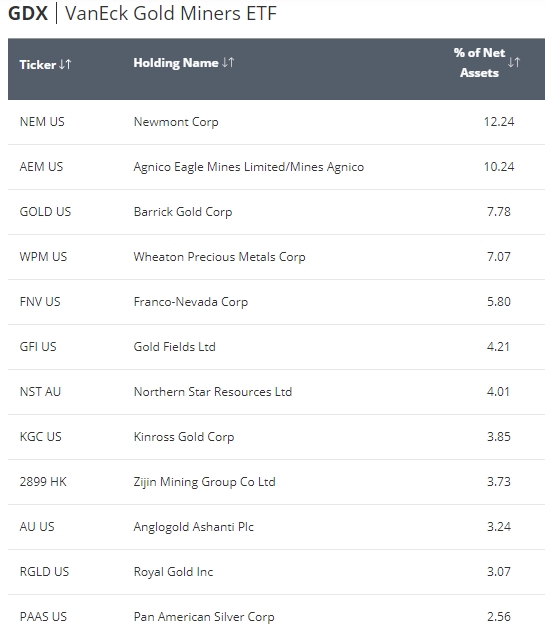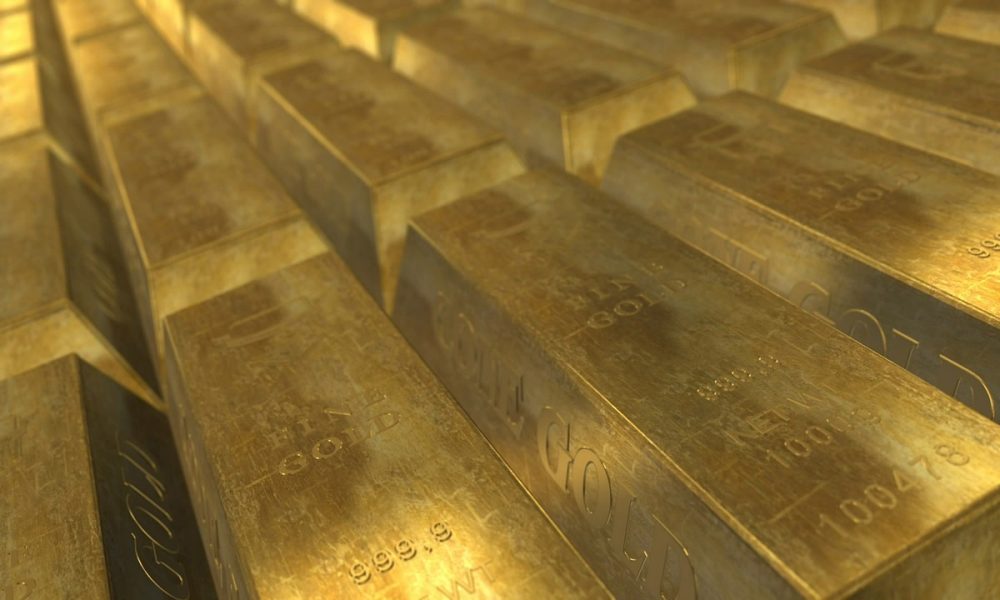Gold Hitting New All-Time-Highs
Since the end of the convertibility of gold into US dollar (USD) in 1971, there have been two gold bull markets in the 1970s and 2000s. And we might be in the midst of a new one, especially with the very strong run in gold in 2024.
Source: Trading Economics
A major driver of each gold run has been concerns about the economy and the persistence of the dominance of the USD over the global financial system.
This is what is driving the current gold bull market again, with the US government piling up debt like never before. And with rising interest rates in parallel, this has caused the interest payment to go above the 1 trillion USD mark for the very first time.

Source: Federal Reserve Bank of St Louis
For reference, this is larger than the US defense budget, itself 40% of the global military spending.
The new Trump administration, including the now very influential Elon Musk, has expressed concerns about this situation.
“We do have an opportunity to do kind of a once-in-a-lifetime deregulation and reduction in the size of government. Because the other thing besides the regulations, America is also going bankrupt extremely quickly, and… everyone seems to be sort of whistling past the graveyard on this one.” – Elon Musk
As gold has historically been a reserve currency without counterparty risk, it is often seen as a safe haven in times of financial uncertainty.
An excellent way to gain exposure to gold is to invest in gold miners, as this is equivalent to buying not only the current production but also the mineral reserves still in the ground.
Why to Invest In Gold ETFs
Gold mining has excited imagination and public greed since the dawn of civilization, as illustrated by expressions like gold rush, gold fever, golden opportunity, fool’s gold, etc.
However, gold is very rare on Earth, and even the best gold deposit usually contains as little as a few grams of gold per ton of rock mined. Combined with possible interference by local government and complex geology, investing in gold miners is as risky as it can be profitable. For example, in November 2024, executives at the gold miner Resolute Mining were detained by the Mali government over a tax dispute, sending the company stock into a tailspin.
By offering an easy-to-invest financial instrument that provides exposure to dozens of gold miners at once, gold ETFs can help diversify this risk.
Gold Focused Exchange Traded Funds (ETFs)
*Note: Metrics are provided in USD and were accurate at the time of writing.*
1. SPDR Gold Trust
By far the largest gold ETF, SPDR differs from others as it does not hold stock but actual gold. The trust owns 877 tons of gold or as much gold reserve as major countries like India or Japan.

Source: World Gold Council
With a value of $75B, it is by far the most liquid gold ETF Trust, with very little difference between the price paid by an investor in GLD and gold spot price. This can actually be a lower premium than actual physical gold an investor can take delivery of in physical form, like gold bars or gold coins.
The ETF’s size also means that it can afford very low management fees, with an expense ratio of only 0.40%.
So this is the closest investors can do to directly own gold without taking physical delivery. However, it does not provide any yield, as it is not an investment in productive companies’ stocks. It also does not provide any leverage against gold prices.
2. VanEck Gold Miners ETF
This is one of the largest gold ETFs focused on gold miners, with $14.3B of assets under management. It has a low net expense ratio of only 0.51%.
Its top 3 holdings are among the largest gold miners in the world: Newmont (NEM -0.01%), Agnico Eagle (AEM +0.51%), and Barrick Gold (GOLD +0%).
This is followed by two of the largest gold royalties gold companies, Franco Nevada (FNV +0.44%) and Wheaton Precious Metal (WPM +0.08%). Royalties companies are financial companies providing non-dilutive investment to mining companies, in exchange for a percentage of future production on a mining site.

Source: VanEck
The rest of the ETF’s top holdings are other large gold mining companies like Kinross Gold (KGC +0.74%), or AngloGold Ashanti (AU +2.6%).
This makes the GDX ETF a good ETF for getting exposure to the top gold companies in the world, including a focus on the largest miners and best jurisdictions in the world.
3. VanEck Junior Gold Miners ETF
While established large gold miners are overall safer, they are also generally priced accordingly. On the contrary, junior miners, a term used for mining companies that have yet to start production, are more speculative and risky.
This is because a lot can go wrong in the 10+ years between the start of a mining project and first production: environmental permitting can be refused, actual geology might prove less good than expected, inflation can cause construction costs to explode beyond expectation, more capital might need to be raised, diluting existing shareholders, etc.
If the gold prices keep rising while junior miners are building up their mines, this could prove very profitable, as investors will have bought them early at a discounted price. But of course, if gold prices crash, the newly started mines might be unprofitable, which can severely damage their stock prices.
So in many ways, gold miners and ETFs like GDXJ are sort of a leveraged bet against gold price.
Contrary to investment in individual juniors, the ETF provides a diversified exposure to smoothen out individual failures.
Like most VanEck ETFs, net expenses fees are rather low at 0.52%.
Maybe a little surprisingly considering its name, GDXJ’s top holdings include a few not-so-junior gold & silver companies that are developing new projects, for example:
- Pan American Silver Corp (PAAS -0.68%), a company that produced 20.4 Moz (Million ounces) of silver and 882 Koz (thousands of pounds) of gold in 2023. It has however major exploration projects in Mexico and Guatemala, sort of qualifying it as a junior.
- Alamos Gold (AGI +0%) has a production of 570 Koz of gold and has multiple exploration-stage projects in Canada and the USA.
Overall, the holding of growth-focused smaller active gold miners means that despite its name, GDXJ is more a mid-way between a mature large gold miner ETF like GDX and an ETF fully dedicated to junior miners.
4. Sprott Junior Gold Miners ETF
This ETF is much more than GDXJ, which is an actual junior gold miner ETF. Its total fees are 0.5%.
The ETF’s top 5 holdings, representing 32.61% of the total assets, are:
- Bumi Resources Minerals Tbk PT (BRMS.JK -0.9%) (11.13% of the ETF’s assets), an Indonesian miner bringing together all the non-coal mines of the larger BUMI Group.
- Westgold Resources (WGX.AX +1.78%) (5.59%), an Australian gold miner building a 400+ Koz gold mine.
- New Gold (NGD -1.39%) (5.56%), a Canadian gold miner with 2 assets in Ontario and British Columbia, has started production and is still ramping up.
- Artemis Gold (ARGTF +7.64%) (5.18%), a Canadian gold miner developing the Blackwater mine in British Colombia, with the first ore produced in November 2024,
- Centamin (CEY.L +2.82%) (5.15%), an Africa-focused gold miner, with a flagship project in Egypt (the Sukari gold mine) and 3 other potential mines (1 in Egypt, 2 in Ivory Coast).
This ETF provides a much wider geographical diversity than others, with a presence in frontier markets like Indonesia or Africa that could feel too risky for most investors to make any direct investment.
By having most of the investments of the ETF only 2-5% of the total, this provides a very strong diversification.
It also capitalized on the experience, knowledge, and network of the Sprott Asset Management company, founded by the legend in mining investing Eric Sprott, worth $1.1B, who claims to hold 90% of his assets in gold and silver.
5. Franklin Responsibly Sourced Gold ETF
Mining, and gold mining in particular, can be done in not-so-ethical ways in many places in the world. While this is especially true for small-scale or illegal mining, established mining companies can also attract unwanted controversy at times due to poor governance.
This relatively recently established ETF aims to alleviate such concerns for gold investors, by guaranteeing that the gold held by the Franklin fund is only sourced from LBMA accredited refiners. As such, these refiners are required to demonstrate their efforts to respect the environment and combat money laundering, terrorist financing and human rights abuses in accordance with the LBMA’s Responsible Gold Guidance.
The fund is also optimizing it costs by sourcing the gold from the NYSE Arca gold market.
